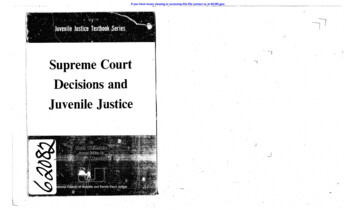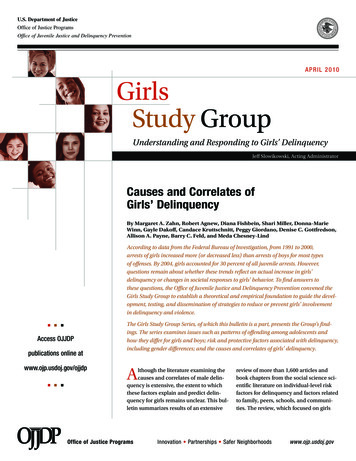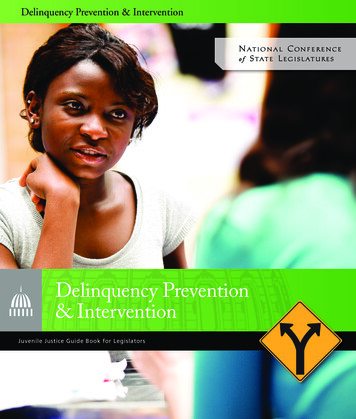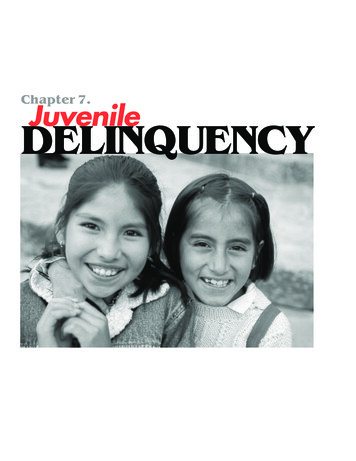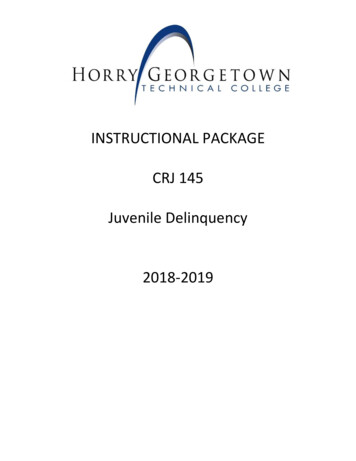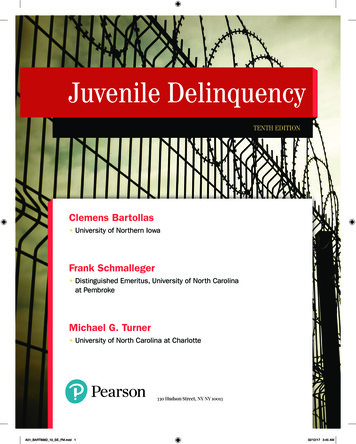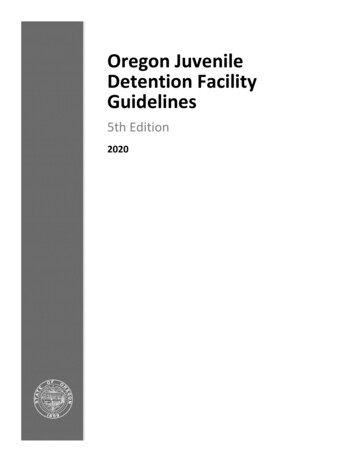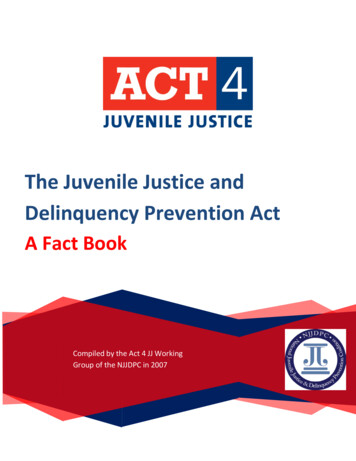
Transcription
The Juvenile Justice andDelinquency Prevention ActA Fact BookCompiled by the Act 4 JJ WorkingGroup of the NJJDPC in 2007
This book was compiled by organizations of the Act 4 JJ working group of the National Juvenile Justiceand Delinquency Prevention Coalition in 2007. There have been some updates to the document toreflect current data and trends. Act 4 JJ is hoping to release a completely updated version of the factbook later this year.For more information contact: Alexandra Staropoli, Esq., Associate Director of Government and FieldRelations, Coalition for Juvenile Justice, 202-467-0864 ext. 109, staropoli@juvjustice.org.
Juvenile Justice GlossaryAdjudication: Judicial determination (judgment) that a juvenile is responsible for thedelinquency or status offense that is charged in a petition or other charging document.Adult Jail: A locked facility, administered by State, county or local law enforcement andcorrectional agencies, designed to detain adults charged with violating criminal law, pendingtrial. Also, this term refers to facilities used to hold convicted adult criminal offenderssentenced for less than 1 year.Adult Lockup: Generally, a municipal or police facility similar to an adult jail designed totemporarily hold persons before they have been formally charged.Aftercare: A cohesive set of support services designed to provide assistance to youthreturning to their community and/or new living situation following their release from a secureor non-secure program, residential placement, or treatment program. Services are designedto assist youth in making a successful transition into the community.Arrest: Hold time in legal custody, either at the scene of a crime or as result ofinvestigations. Arrest also can be the result of a complaint filed by a third party, anoutstanding warrant, or a revocation of probation or parole.Best Practice: Strategies and programs demonstrated though research and evaluation to beeffective at preventing or intervening in juvenile justice delinquency. Best practice modelsinclude program models that have been shown, through rigorous evaluation and replication,to achieve target outcomes. Model programs can come from many valid sources (e.g., OJJDP’sModel Programs Guide, Blueprints, Substance Abuse and Mental Health ServicesAdministration’s (SAMHSA) Model Programs, State model program resources, etc.)Case Management: A system of services that include referral, assessment, intervention,problem solving, evaluation, and follow-up.Community-based: A facility, program, or service located near the juvenile’s home or family,usually a group home or other appropriate setting. Also, the term refers to programs ofcommunity supervision and services that maintain community and consumer participation inprogram planning, operation, and evaluation.Commitment: A court order giving guardianship of a juvenile to the state department ofjuvenile justice or corrections. The facility in which a juvenile is placed may be publicly orprivately operated and may range from a secure correctional placement to a non-secure orstaff secure facility, group home, foster care, or day treatment setting.Compliance: In order to receive its full fiscal year allocation of Formula Grants program fundsunder the JJDPA, a state must first demonstrate compliance with the DSO, jail removal,separation, and DMC core requirements. Compliance with the first three core requirements isdemonstrated though data provided in the state’s annual Compliance Monitoring Report.Compliance with the DMC Core requirement is determined by information provided in the
state’s Comprehensive Three-Year Plan and subsequent Three-Year Plan Updates. Fullcompliance with each core requirement is achieved when:Deinstitutionalization of Status Offenders: a state has removed 100 percent of statusoffenders and non-offenders from secure detention correctional facilities.Jail Removal: a state demonstrates that the last submitted monitoring report,covering 12 months of actual data, demonstrates that no juveniles were held in adultjails or lockups in circumstances that were in violation of jail removal.OJJDP has developed de minimis standards for states that have not achieved fullcompliance with the DSO and jail removal requirements. See the OJJDP GuidanceManual for Monitoring Facilities Under the Juvenile Justice and Delinquency PreventionAct of 2002 for further details.Separation: a State can demonstrate that (a) the last submitted monitoring report,covering a full 12 months of data, demonstrates that no juveniles were incarcerated incircumstances that were in violation of this requirement; or (b) the instances ofnoncompliance reported in the last submitted monitoring report do not indicate apattern or practice but rather constitute isolated instances.Disproportionate Minority Contact: A state can demonstrate progress made each yearin addressing specific delinquency prevention and system improvement efforts toreduce the rate of contact with the juvenile justice system of a specific minoritygroup, if that rate is significantly greater than the rate of contact for whites or otherminority groups.Compliance Monitoring Report: OJJDP’s Formula Grant Regulation requires states to submitinformation regarding compliance with the DSO, jail removal, and separation requirementsannually. This information is submitted through the Compliance Monitoring (CM) report.States that have been determined by the OJJDP Administrator to have achieved fullcompliance may be exempt from the annual monitoring report requirements following awritten request.Delinquency: An act committed by a juvenile that would be criminal if committed by anadult. The juvenile court has jurisdiction over delinquent acts. Delinquent acts include crimesagainst persons, crimes against property, drug offenses, and crimes against public order.Detention: The placement of a youth in a secure facility under court authority at some pointbetween the time of referral to court intake and case disposition. Detention prior to casedisposition is known as pre-dispositional detention. The reasons for post-dispositionaldetention generally include awaiting placement, short-term sentencing to detention, or beinga danger to self or others.Discretionary funds: Grants other than the JJDPA Formula Grants that OJJDP makes directlyto individuals or agencies to provide specific juvenile services.Disposition: Sanction ordered or treatment plan decided upon or initiated in a particular caseby a juvenile court. The range of options available to a court typically includes commitment
to an institution; placement in a group or foster home or other residential facility; probation(either regular or intensive supervision); referral to an outside agency, day treatment, ormental health program; or imposition of a fine, community service, or restitution.Diversion: A mechanism designed to hold youth accountable for their actions by sanctioningbehavior and in some cases securing services, but at the same time generally avoiding formalcourt processing in the juvenile justice system.Formal Petition filed: A case that is being forwarded for judicial resolution and is muchsmaller in number than the number of cases coming though the intake process.Formula Grants: The Formula Grants Program, funded by the OJJDP, which provides grantmonies to State and territories that support State and local delinquency prevention andintervention efforts and juvenile justice system improvements. Juvenile Justice Specialists ineach State administer the funding through sub-grants to units of local government, localprivate agencies, and Indian tribes for programs in accordance with legislative requirements.Gender-specific services: Services designed to promote healthy attitudes, behaviors andlifestyles, and promote social competence in girls. Key program elements generally addressissues in the context of relationships to peers, family, school, and community.Goals: Broad statements (i.e., written in general terms) that convey a program’s overallintent to change, reduce, or eliminate the problem described. Goals identify the program’sintended short-and long-term results.Graduated Sanctions: A graduated sanctions system is a set of integrated interventionstrategies designed to operate in unison to enhance accountability, ensure public safety, andreduce recidivism by preventing future delinquent behavior. The term “graduated sanctions”implies that the penalties for delinquent activity should move from limited interventions tomore restrictive (i.e., graduated) penalties according to the severity and nature of the crime.In other words, youth who commit serious and violent offenses should receive more restrictivesentences than youth who commit less serious offenses.Grants: An award of financial assistance, the principal purpose of which is to transfer a thingof value from a Federal or State agency to a recipient to carry out a public purpose of supportor stimulation authorized by a law of the United States (see 31 U.S.C. 6101(3)). A grant isdistinguished from a contract, which is used to acquire property or services for the FederalGovernment’s direct benefit or use.Juvenile: Youth at or below the upper age of original juvenile court jurisdiction, which variesdepending on the State (e.g., the age is 15 in some States, and 17 in others).Juvenile Justice and Delinquency Prevention Act: Congress enacted the Juvenile Justiceand Delinquency Prevention Act (JJDPA) (P.L. No. 93-415, 42 U.S.C. & 5601 et seg.) in 1974and reauthorized the majority of its provisions in 2002. The JJDPA mandates that statescomply with four core requirements to participate in the JJDPA’s Formula Grants programs.This landmark legislation established OJJDP to support local and state efforts to preventdelinquency and improve the juvenile justice system.
Non-offender: A juvenile who is subject to the jurisdiction of the juvenile court usually underabuse, dependency, or neglect statutes for reasons other than legally prohibited conduct.Objectives: Derived from the program goals and explain how the program goal will beaccomplished. Objectives are well-defined, specific, quantifiable statements of the program’sdesired results and they should include the target level of accomplishment, thereby furtherdefining goals and providing the means to measure program performance.Parole: A conditional release from imprisonment that entitles the person to serve theremainder of the sentence outside the correctional institution as long as the terms of therelease are not violated.Post-disposition: The period following the imposition of a sanction ordered or treatment plandecided upon or initiated in a particular case by a juvenile court.Pre-disposition: The period after the filing of a charge and prior to a sanction ordered ortreatment plan decided upon or initiated in a particular case by juvenile court.Probation: Cases in which youth are placed on informal/voluntary or formal/court-orderedsupervision. A violation occurs when a youth violates the terms of the probation.Secure: As used to define a detention or correctional facility, this term includes residentialand non-residential facilities that include fixtures, such as locked rooms and buildings,fences, or other physical structures, designed to physically restrict the movements andactivities of persons in custody. It does not include facilities where physical restriction ofmovement or activities is provided solely through facility staff.Status Offenders: A juvenile charged with or adjudicated for conduct that would not, underthe law of the jurisdiction in which the offense was committed, be a crime if committed byan adult. Status offenses include truancy, curfew violations, incorrigibility, running away, andunderage possession and/or consumption of alcohol or tobacco.Title V: The Title V Community Prevention Grants Program is a federal grants program to fundcollaborative, community-based delinquency prevention efforts. The program provides localcommunities with funding and a guiding framework for developing and implementingcomprehensive juvenile delinquency prevention plans.Type 1 crimes: Classification used by the FBI, traditionally used as a measure of seriouscrimes, including murder, rape, robbery, aggravated assault, burglary, larceny, motor vehicletheft, and arson. Also referred to as index crimes.Unit of general local government: Any city, county, township, town, borough, parish,village, or the general purpose political subdivision of a state and Indian tribe that performslaw enforcement functions as determined by the U.S. Secretary of the Interior for the purposeof assistance eligibility, any agency of the District of Columbia government performing lawenforcement functions in and for the District of Columbia, and funds appropriated by the U.S.Congress for the activities of such agency may be used to provide the non-federal shares ofthe cost of programs or projects funded under the JJDPA.
Valid court order: An order given by a juvenile court judge to a juvenile who was broughtbefore the court and made subject to an order; and who received, before the issuance ofsuch order, the full due process rights guaranteed to such juvenile by the U.S. Constitution.Valid court order exception: Permits the secure/locked detention of a juvenile for violationof a court order only if he or she received full due process as guaranteed by the U.S.Constitution.Waived to criminal court: Cases that originated in juvenile court but are transferred to adultcriminal court as the result of a judicial waiver hearing in juvenile court.
Abbreviations and AcronymsABAAmerican Bar AssociationBARJBalanced and Restorative JusticeBIABureau of Indian Affairs, U.S. Department of the InteriorBJABureau of Justice Assistance, U.S. Department of JusticeBJSBureau of Justice Statistics, U.S. Department of JusticeCJJCoalition for Juvenile JusticeCWLAChild Welfare League of AmericaDOJU.S. Department of JusticeDMCDisproportionate Minority ContactDSADesignated State AgencyDSODeinstitutionalization of Status OffendersHHSU.S. Department of Health and Human ServicesJABGJuvenile Accountability Block GrantJJACJuvenile Justice Advisory CouncilJJAGJuvenile Justice Advisory GroupJJDPAJuvenile Justice and Delinquency Prevention ActJJSJuvenile Justice SpecialistNACONational Association of CountiesNCJFCJNational Council of Juvenile and Family Court JudgesNCCDNational Council on Crime and DelinquencyNCJANational Criminal Justice AssociationNGANational Governors Association
NTTACNational Training and Technical Assistance CenterOGCOffice of General Counsel, U.S. Department of JusticeOJJDPOffice of Juvenile Justice and Delinquency Prevention, U.S. Department ofJusticeOJPOffice of Justice Programs, U.S. Department of JusticeRFPRequest for ProposalsSACStatistical Analysis CenterSAGState Advisory GroupSRADOJJDP’s State Relations and Assistance DivisionTATechnical AssistanceT&TATraining and Technical Assistance
Juvenile Justice System Structure and ProcessCase Flow DiagramThe case flow diagram describes the stages of delinquency case processing in the juvenile justice system.Source: http://www.ojjdp.gov/ojstatbb/structure process/images/flowbluemedwebalt2.gif
Juvenile Justice System Structure and ProcessSource: http://www.ojjdp.gov/ojstatbb/structure process/case.html (The following is anexcerpt from the Juvenile Offenders and Victims: A National Report publication, NCJ 153569,pages 76–79. The statistics have been updated to reflect the latest available data.)Young law violators generally enter the juvenile justice system through lawenforcement.Each State's processing of law violators is unique:Even within States, case processing often varies from community to community depending onlocal practice and tradition. Consequently, any description of juvenile justice processing mustbe general, outlining a common series of decision points.Law enforcement diverts many juvenile offenders out of the justice system:At arrest, a decision is made either to send the matter further into the justice system or todivert the case out of the system, often into alternative programs. Usually, law enforcementmakes this decision, after talking to the victim, the juvenile, and the parents, and afterreviewing the juvenile's prior contacts with the juvenile justice system. Twenty-two percentof all juveniles arrested in 2009 were handled within the police department and thenreleased. Seventy percent of arrested juveniles were referred to juvenile court.Federal regulations discourage holding juveniles in adult jails and lockups. If law enforcementmust detain a juvenile in secure custody for a brief period in order to contact a parent orguardian or to arrange transportation to a juvenile detention facility, Federal regulationsrequire that the juvenile be securely detained for no longer than 6 hours and in an area thatis not within sight or sound of adult inmates.Most juvenile court cases are referred by law enforcement:Law enforcement referrals accounted for 83% of all delinquency cases referred to juvenilecourt in 2009. The remaining referrals were made by others such as parents, victims, schools,and probation officers.The court intake function is generally the responsibility of the juvenile probation departmentand/or the prosecutor's office. At this point intake must decide either to dismiss the case,handle the matter informally, or request formal intervention by the juvenile court.To make this decision, an intake officer first reviews the facts of the case to determine ifthere is sufficient evidence to prove the allegation. If there is not, the case is dismissed. Ifthere is sufficient evidence, intake will then determine if formal intervention is necessary.About half of all cases referred to juvenile court intake are handled informally. Mostinformally processed cases are dismissed. In the other informally processed cases, thejuvenile voluntarily agrees to specific conditions for a specific time period. These conditions11
are often outlined in a written agreement, generally called a "consent decree." Conditionsmay include such items as victim restitution, school attendance, drug counseling, or a curfew.In most jurisdictions, a juvenile may be offered an informal disposition only if he or sheadmits to committing the act. The juvenile's compliance with the informal agreement is oftenmonitored by a probation officer. Consequently, this process is sometimes labeled "informalprobation."If the juvenile successfully complies with the informal disposition, the case is dismissed. If,however, the juvenile fails to meet the conditions, the intake decision may be to formallyprosecute the case, and the case will proceed just as it would have if the initial decision hadbeen to refer the case for an adjudicatory hearing.During the processing of a case, a juvenile may be held in a secure detention facility:Juvenile courts may hold delinquents in a secure detention facility if the court believes it is inthe best interest of the community or the child. After arrest a youth is often brought to thelocal juvenile detention facility by law enforcement. Juvenile probation officers or detentionworkers review the case and decide if the juvenile should be held pending a hearing by ajudge.In all States, a detention hearing must be held within a time period defined by statute,generally within 24 hours. At the detention hearing a judge reviews the case and determinesif continued detention is warranted. As a result of the detention hearing the youth may bereleased or detention continued. In 2009 juveniles were detained in 1 in 5 (21%) delinquencycases processed by the juvenile courts. Detention may extend beyond the adjudicatory anddispositional hearings. In some cases crowded juvenile facilities require that detentioncontinue beyond adjudication until a bed becomes available in a juvenile correctionalinstitution or treatment facility.Prosecutors may file a case in either juvenile or criminal court:In many States prosecutors are required to file certain (generally serious) cases involvingjuveniles in the criminal court. These are cases in which the legislature has decided thejuvenile should be handled as a criminal offender. In a growing number of States thelegislature has given the prosecutor the discretion of filing a defined list of cases in eitherjuvenile or adult court. In these States both the juvenile and adult courts have originaljurisdiction over these cases, and the prosecutor selects the court that will handle thematter.If the case is handled in juvenile court, two types of petitions may be filed: delinquency orwaiver. A delinquency petition states the allegations and requests the juvenile courtto adjudicate (or judge) the youth a delinquent, making the juvenile a ward of the court. Thislanguage differs from that used in the criminal court system (where an offenderis convicted and sentenced).12
In response to the delinquency petition, an adjudicatory hearing is scheduled. At theadjudicatory hearing (trial), witnesses are called and the facts of the case are presented. Innearly all adjudicatory hearings the determination that the juvenile was responsible for theoffense(s) is made by a judge; although, in some States the juvenile is given the right to ajury trial. In 2009, juveniles were adjudicated delinquent in 59% of cases petitioned tojuvenile court for criminal law violations.Intake may ask the juvenile court to transfer the case to criminal court:A waiver petition is filed when the prosecutor or intake officer believes that a case underjurisdiction of the juvenile court would be more appropriately handled in criminal court. Thecourt decision in these matters follows a review of the facts of the case and a determinationthat there is probable cause to believe that the juvenile committed the act. With thisestablished, the court then considers whether jurisdiction over the matter should be waivedand the case is transferred to criminal court.This decision generally centers around the issue of whether the juvenile is amenable totreatment in the juvenile justice system. The prosecution may argue that the juvenile hasbeen adjudicated several times previously and that interventions ordered by the juvenilecourt have not kept the juvenile from committing subsequent criminal acts. The prosecutormay argue that the crime is so serious that the juvenile court is unlikely to be able tointervene for the time period necessary to rehabilitate the youth.If the judge agrees that the case should be transferred to criminal court, juvenile courtjurisdiction over the matter is waived and the case is filed in criminal court. If the judge doesnot approve the waiver request, an adjudicatory hearing is scheduled in juvenile court.Between the adjudication decision and the disposition hearing, an investigation report isprepared by probation staff:Once the juvenile is adjudicated delinquent, a disposition plan is developed. To prepare thisplan, probation staff develop a detailed understanding of the youth and assess availablesupport systems and programs. To assist in preparation of disposition recommendations, thecourt may order psychological evaluations, diagnostic tests, or a period of confinement in adiagnostic facility.At the disposition hearing, dispositional recommendations are presented to the judge. Theprosecutor and the youth may also present dispositional recommendations. After consideringoptions presented, the judge orders a disposition in the case.Most cases placed on probation also receive other dispositions:Most juvenile dispositions are multi-faceted. A probation order may include additionalrequirements such as drug counseling, weekend confinement in the local detention center,and community or victim restitution. The term of probation may be for a specified period oftime or open ended. Review hearings are held to monitor the juvenile's progress and to hearreports from probation staff. After conditions of the probation have been successfully met,13
the judge terminates the case. In 2009, 60% of adjudicated delinquents were placed onformal probation.The judge may order the juvenile committed to a residential placement:Residential commitment may be for a specific or indeterminate ordered time period. In 2009,27% of adjudicated delinquents were placed in a residential facility. The facility may bepublicly or privately operated and may have a secure prison-like environment or a more open,even home-like setting. In many States, when the judge commits a juvenile to the Statedepartment of juvenile corrections, the department determines where the juvenile will beplaced and when the juvenile will be released. In other instances the judge controls the typeand length of stay. In these situations review hearings are held to assess the progress of thejuvenile.Juvenile aftercare is similar to adult parole:Following release from an institution, the juvenile is often ordered to a period of aftercare orparole. During this period the juvenile is under supervision of the court or the juvenilecorrections department. If the juvenile does not follow the conditions of aftercare, he or shemay be recommitted to the same facility or to another facility.The processing of status offense cases differs from that of delinquency cases:A delinquent offense is an act committed by a juvenile for which an adult could beprosecuted in criminal court. There are, however, behaviors that are law violations only foryouth of juvenile status. These "status offenses" may include such behaviors as running awayfrom home, truancy, ungovernability, curfew violations, and underage drinking. In many waysthe processing of status offense cases parallels that of delinquency cases.Not all cases, however, consider all of these behaviors to be law violations. Many States viewthese behaviors as indicators that the child is in need of supervision and respond to thebehavior through the provision of social services. This different characterization of statusoffenses causes them to be handled more like dependency than delinquency cases.While many status offenders enter the juvenile justice system through law enforcement, inmany States the initial, official contact is a child welfare agency. Nearly half (59%) of allpetitioned status offense cases referred to juvenile court in 2009 were from law enforcement.The Juvenile Justice and Delinquency Prevention Act discourages the holding of statusoffenders in secure juvenile facilities, either for detention or placement. This policy has beenlabeled deinstitutionalization of status offenders. An exception to this policy occurs whenthe status offender violates a valid court order such as a probation order that requires theadjudicated status offender to attend school and observe a court-ordered curfew. In suchsituations, the status offender may be confined in a secure detention facility.14
Quick Facts: Youth in the Justice SystemYouth CrimeYouth commit only a small portion of the nation’s crime. Youth under age 18 accounted foronly 14% of all arrests. 1 In 2009, 11% of violent crime 17% of property crime involved onlyyouth. 2Youth crime has also declined. While the number of adults arrested between 2000 and 2009only decreased by 1%, the number of youth arrested dropped a staggering 20% during thesame time frame. 3Juvenile CourtEvery year, juvenile courts in the U.S. handle an estimated 1.7 million cases in which a youthwas charged with a delinquency offense, approximately 4,600 delinquency cases per day. 4Juvenile Detention & CorrectionsDetained youth are those who are held in a residential facility awaiting a hearing in court.Youth in detention are separated from their community and their normal day-to-day life(school, jobs, etc.).1 out of every 5 (21 %) youth who are brought before the court with a delinquency case isdetained. 5Juvenile detention is over used in this country. While detention facilities are meant totemporarily house youth who are a danger to themselves or society or who are likely to skiptheir court date, many youth held in detention do not meet these criteria. 61Federal Bureau of Investigation. Crime in the United States 2009. Washington, D.C. Retrieved July 12, 2011fromhttp://www.fbi.gov/ucr/cius2009/data/table 28.html.2Federal Bureau of Investigation. Crime in the United States 2009. Washington, D.C. Retrieved July 12, 2011fromhttp://www.fbi.gov/ucr/cius2009/data/table 32.html.3Federal Bureau of Investigation. Crime in the United States 2009. Washington, D.C., Retrieved July 12, 2011 fromhttp://www.fbi.gov/ucr/cius2009/data/table 32.html4Puzzanchera, C., Adams, B., and Sickmund, M. (2010). Juvenile Court Statistics 2006-2007. Pittsburgh, PA:National Center for Juvenile Justice.5OJJDP Statistical Briefing Book. Online. 301.asp?qaDate 2008. Released on May 06, 2011.15
Two-thirds of youth in detention are held for nonviolent charges. These youth are chargedwith property offenses, public order offenses, technical probation violations, or “statusoffenses” (crimes that wouldn’t be crimes if they were adults, like running away or breakingcurfew). 7Youth of color are overrepresented in the detention population. In 2003, African-Americanyouth were detained at a rate 4.5 times higher than whites. Latino youth were detained attwice the rate of whites. 8One quarter (25%) of detention centers are at or over their capacity, which impairs the abilityof the facility to properly care for the youth. 9A one-day snapshot of youth in detention found that roughly 2% were status offenders.However, this number does not account for the number of youth who are held in detentionfacilities after violating a valid court order. 10On any given day, over 50,000 youth found to be delinquent are in juvenile correctionalfacilities after violating a valid court order. 11Adjudicated youth sent to residential placements increas
This book was compiled by organizations of the Act 4 JJ working group of the National Juvenile Justice and Delinquency Prevention Coalition in 2007. There have been some updates to the document to reflect current data and trends. Act 4 JJ is hoping to release a completely updated version of the fact book later this year.


